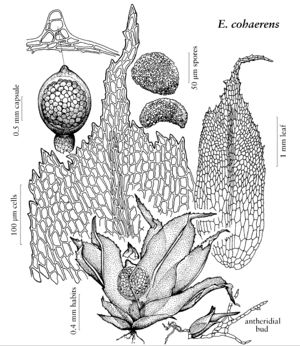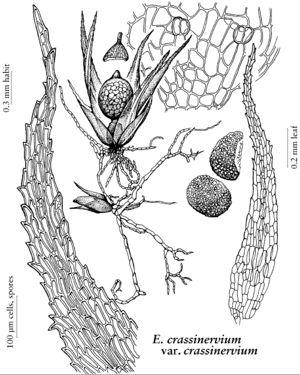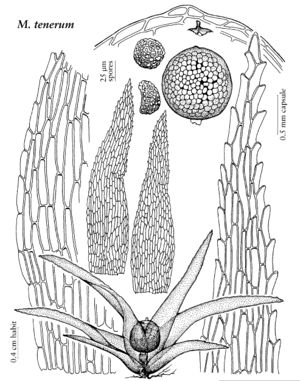FNA>Volume Importer |
FNA>Volume Importer |
||
| Line 12: | Line 12: | ||
}}<!-- | }}<!-- | ||
| − | --><span class="statement" id="st-undefined" data-properties=""><b>Plants </b>leafy ephemerals, less than 3 mm, solitary, scattered, or gregarious on sparse or abundant protonemata with upright, aerial, determinate branches, green, pale-yellow, or brown. <b>Stem</b> virtually absent or to 1 mm (to 3.7 mm in Micromitrium synoicum), rhizoids absent or few. <b>Leaves</b> rarely more than 12, the proximal small, broadly triangular to ovate, ecostate, apex acuminate, the distal becoming larger, linear, lanceolate, or ligulate, with or without shoulders, margins distal to the middle entire, serrulate, serrate, or spinose, apex acuminate; costate or ecostate; laminal cells lax and transparent, long-rhomboidal to rectangular, in some species becoming denser distally, smooth, papillose by projecting distal ends, or spinose. <b>Specialized</b> asexual reproduction by fragments and rarely by thick-walled elongate, swollen protonematal segments, commonly brown, and persisting on or in the soil. <b>Sexual</b> condition autoicous, dioicous, or synoicous. <b>Perigonia</b> arising from the protonemata, from rhizoids, or just proximal to the perichaetium; small, bud-like with ecostate leaves of lax areolation, broadly triangular to broadly ovate. <b>Perichaetium</b> consisting of the 1–3 most distal leaves on the stem, typically the largest and best developed. <b>Vaginula</b> conspicuous. <b>Sporophytes</b> 1–3 per perichaetium with immersed to emerging capsules. <b>Seta</b> virtually absent or very short. <b>Capsule</b> globose or ovoid, without or with an apiculus, cleistocarpous or opening along an indistinct or distinct ring of cells near the equator; exothecium of 1–2 layers of lax and thin-walled cells; stomates absent or superficial with two guard cells. <b>Calyptra</b> persistent, mitrate, and minute, or fugacious, mitrate or cucullate, and irregularly lobed or torn at the base, covering up to 2/3 of the capsule. <b>Spores</b> appearing reniform, globose, or variously angled, 20–120 µm, ranging from barely papillose to coarsely warty, the elaboration often correlating with degree of maturity, usually bearing small remnants of a hyaline membrane, orange, red, brown, or black.</span><!-- | + | --><span class="statement" id="st-undefined" data-properties=""><b>Plants </b>leafy ephemerals, less than 3 mm, solitary, scattered, or gregarious on sparse or abundant protonemata with upright, aerial, determinate branches, green, pale-yellow, or brown. <b>Stem</b> virtually absent or to 1 mm (to 3.7 mm in <i>Micromitrium synoicum</i>), rhizoids absent or few. <b>Leaves</b> rarely more than 12, the proximal small, broadly triangular to ovate, ecostate, apex acuminate, the distal becoming larger, linear, lanceolate, or ligulate, with or without shoulders, margins distal to the middle entire, serrulate, serrate, or spinose, apex acuminate; costate or ecostate; laminal cells lax and transparent, long-rhomboidal to rectangular, in some species becoming denser distally, smooth, papillose by projecting distal ends, or spinose. <b>Specialized</b> asexual reproduction by fragments and rarely by thick-walled elongate, swollen protonematal segments, commonly brown, and persisting on or in the soil. <b>Sexual</b> condition autoicous, dioicous, or synoicous. <b>Perigonia</b> arising from the protonemata, from rhizoids, or just proximal to the perichaetium; small, bud-like with ecostate leaves of lax areolation, broadly triangular to broadly ovate. <b>Perichaetium</b> consisting of the 1–3 most distal leaves on the stem, typically the largest and best developed. <b>Vaginula</b> conspicuous. <b>Sporophytes</b> 1–3 per perichaetium with immersed to emerging capsules. <b>Seta</b> virtually absent or very short. <b>Capsule</b> globose or ovoid, without or with an apiculus, cleistocarpous or opening along an indistinct or distinct ring of cells near the equator; exothecium of 1–2 layers of lax and thin-walled cells; stomates absent or superficial with two guard cells. <b>Calyptra</b> persistent, mitrate, and minute, or fugacious, mitrate or cucullate, and irregularly lobed or torn at the base, covering up to 2/3 of the capsule. <b>Spores</b> appearing reniform, globose, or variously angled, 20–120 µm, ranging from barely papillose to coarsely warty, the elaboration often correlating with degree of maturity, usually bearing small remnants of a hyaline membrane, orange, red, brown, or black.</span><!-- |
-->{{Treatment/Body | -->{{Treatment/Body | ||
| Line 57: | Line 57: | ||
|publication year= | |publication year= | ||
|special status= | |special status= | ||
| − | |source xml=https://jpend@bitbucket.org/aafc-mbb/fna-data-curation.git/src/ | + | |source xml=https://jpend@bitbucket.org/aafc-mbb/fna-data-curation.git/src/8f726806613d60c220dc4493de13607dd3150896/coarse_grained_fna_xml/V27/V27_952.xml |
}}<!-- | }}<!-- | ||
-->[[Category:Treatment]] | -->[[Category:Treatment]] | ||
Revision as of 16:58, 18 September 2019
Plants leafy ephemerals, less than 3 mm, solitary, scattered, or gregarious on sparse or abundant protonemata with upright, aerial, determinate branches, green, pale-yellow, or brown. Stem virtually absent or to 1 mm (to 3.7 mm in Micromitrium synoicum), rhizoids absent or few. Leaves rarely more than 12, the proximal small, broadly triangular to ovate, ecostate, apex acuminate, the distal becoming larger, linear, lanceolate, or ligulate, with or without shoulders, margins distal to the middle entire, serrulate, serrate, or spinose, apex acuminate; costate or ecostate; laminal cells lax and transparent, long-rhomboidal to rectangular, in some species becoming denser distally, smooth, papillose by projecting distal ends, or spinose. Specialized asexual reproduction by fragments and rarely by thick-walled elongate, swollen protonematal segments, commonly brown, and persisting on or in the soil. Sexual condition autoicous, dioicous, or synoicous. Perigonia arising from the protonemata, from rhizoids, or just proximal to the perichaetium; small, bud-like with ecostate leaves of lax areolation, broadly triangular to broadly ovate. Perichaetium consisting of the 1–3 most distal leaves on the stem, typically the largest and best developed. Vaginula conspicuous. Sporophytes 1–3 per perichaetium with immersed to emerging capsules. Seta virtually absent or very short. Capsule globose or ovoid, without or with an apiculus, cleistocarpous or opening along an indistinct or distinct ring of cells near the equator; exothecium of 1–2 layers of lax and thin-walled cells; stomates absent or superficial with two guard cells. Calyptra persistent, mitrate, and minute, or fugacious, mitrate or cucullate, and irregularly lobed or torn at the base, covering up to 2/3 of the capsule. Spores appearing reniform, globose, or variously angled, 20–120 µm, ranging from barely papillose to coarsely warty, the elaboration often correlating with degree of maturity, usually bearing small remnants of a hyaline membrane, orange, red, brown, or black.
Distribution
Nearly worldwide in temperate and tropical regions.
Discussion
Genera 2, species ca. 35 (2 genera, 8 species in the flora).
The Ephemeraceae are usually found in sunny or partly shaded areas, on moist or drying disturbed soil, where there is little competition from more persistent mosses and larger plants. They are visible for the most part as patches of greenish, alga-like protonemata with minute leafy plants and are best seen in the field when the protonemal mass is most abundant and green, with leafy plants that are green and approaching maturity.
The distinguishing characters of the leaves are derived from the largest, usually the most distal, leaves. The middle and proximal leaves vary in shape, marginal cells, and costal development. For example, the distal leaves bear the well-developed costa, but the proximal leaves are usually ecostate, and the middle leaves vary from ecostate to weakly or markedly costate. In the nominally ecostate species the proximal and middle leaves are ecostate, but the largest leaves, while in a strict sense ecostate, may have in the costal position thicker walled cells or a few undifferentiated cells in a double layer. As seen in cross-section, the double-layered cells are not organized as a costa and do not differ from other laminal cells, except that they may have very slightly thicker walls. In surface view the double layer is barely distinguishable.
Selected References
Lower Taxa
Illustrations
| Family ⠉ | Taxon | Illustrator ⠉ | |
|---|---|---|---|
 | Ephemeraceae | Ephemerum cohaerens | Patricia M. Eckel |
 | Ephemeraceae | Ephemerum crassinervium var. crassinervium | Patricia M. Eckel |
 | Ephemeraceae | Micromitrium tenerum | Patricia M. Eckel |
Key
| 1 | Calyptra minute, tightly adherent at or near the apex of the capsule, persistent; capsule cleistocarpous or with a ring of differentiated cells at or just distal to the equator, ± globose, without a well-developed, multicellular apiculus; costa commonly absent, but occasionally suggested by a few median cells with thick walls or in a short and indistinct double layer distal to the leaf middle; laminal cells lax, hyaline, smooth. | Micromitrium |
| 1 | Calyptra covering most of the distal half of the capsule, fugacious; capsule cleistocarpous, ovoid, and distinctly apiculate; costa well-developed, except mostly absent in Ephemerum serratum; laminal cells of the leaves lax in the proximal half and in the distal half firmer, smaller, and usually papillose. | Ephemerum |